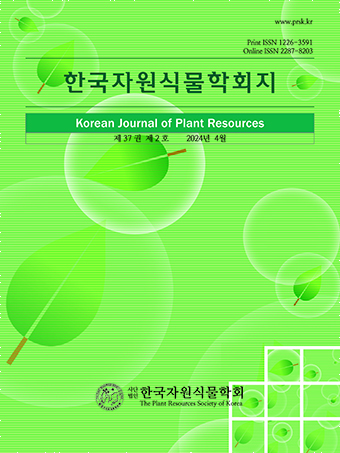Research Article
Abstract
References
Information
China Plant BOL Group, D.Z. Li, L.M. Gao, H.T. Li, H. Wang, X.J. Ge, J.Q. Liu, Z.D. Chen, S.L. Zhou, S.L. Chen, J.B. Yang, C.X. Fu, C.X. Zeng, H.F. Yan, Y.J. Zhu, Y.S. Sun, S.Y. Chen, L. Zhao, K. Wang, T. Yang and G.W. Duan. 2011. Comparative analysis of a large dataset indicates that internal transcribed spacer (ITS) should be incorporated into the core barcode for seed plants. PNASU. 108(49):19641-19646.
10.1073/pnas.110455110822100737PMC3241788
Chun, J.B., M. Jin, N. Jeong, C. Cho, M.S. Seo, M.S. Choi, D.Y. Kim, H.B. Sohn and Y.H. Kim. 2019. Genetic identification and phylogenic analysis of new varieties and 149 Korean cultivars using 27 InDel markers selected from dense variation blocks in Soybean (Glycine max (L.) Merrill). Korean J. Plant Res. 32(5):519-542.
Fazekas, A.J., K.S. Burgess, P.R. Kesanakurti, S.W. Graham, S.G. Newmaster, B.C. Husband, D.M. Percy, M. Hajibabaei and S. C. Barrett. 2008. Multiple multilocus DNA barcodes from the plastid genome discriminate plant species equally well. PloS One 3(7):e2802.
10.1371/journal.pone.000280218665273PMC2475660
Guo, L., Z. Sui, S. Zhang, Y. Ren and Y. Liu. 2015. Comparison of potential diatom ‘barcode’genes (the 18S rRNA gene and ITS, COI, rbcL) and their effectiveness in discriminating and determining species taxonomy in the Bacillariophyta. Int. J. Syst. Evol. Micr. 65(4):1369-1380.
10.1099/ijs.0.00007625604341
Jansen, R.K., C. Kaittanis, C. Saski, S.B. Lee, J. Tomkins, A.J. Alverson and H. Daniell. 2006. Phylogenetic analyses of Vitis (Vitaceae) based on complete chloroplast genome sequences: Effects of taxon sampling and phylogenetic methods on resolving relationships among rosids. BMC Evol. Biol. 6(1):1-14.
10.1186/1471-2148-6-3216603088PMC1479384
Shaw, J., E.B. Lickey, J.T. Beck, S.B. Farmer, W. Liu, J. Miller, K.C. Siripun, C.T. Winder, E.E. Schilling and R.L. Small. 2005. The tortoise and the hare II: Relative utility of 21 noncoding chloroplast DNA sequences for phylogenetic analysis. Am. J. Bot. 92(1):142-166.
10.3732/ajb.92.1.14221652394
Soltis, D.E., P.S. Soltis, D.L. Nickrent, L.A. Johnson, W.J. Hahn, S.B. Hoot, J.A. Sweere, R.K. Kuzoff, K.A. Kron, M.W. Chase, S.M. Swensen, E.A. Zimmer, S.M. Chaw, L.J. Gillespie, W.J. Kress and K.J. Sytsma. 1997. Angiosperm phylogeny inferred from 18S ribosomal DNA sequences. Ann. Mo. Bot. Gard. 84(1):1-49.
10.2307/2399952
Yoon, C.Y., K.W. Park, J. Jung, J.Y. Hyun and J.H. Kim. 2019. A report on the taxonomic characters, ecological risk and weed risk assessment of un-introduced plants which are designated in law by the Ministry of Environment in Korea as environmentally harmful species (I). Korean J. Plant Res. 32(5):543-558.
- Publisher :The Plant Resources Society of Korea
- Publisher(Ko) :한국자원식물학회
- Journal Title :Korean Journal of Plant Resources
- Journal Title(Ko) :한국자원식물학회지
- Volume : 35
- No :2
- Pages :346-361
- Received Date : 2021-12-09
- Revised Date : 2022-03-21
- Accepted Date : 2022-03-25
- DOI :https://doi.org/10.7732/kjpr.2022.35.2.346




 Korean Journal of Plant Resources
Korean Journal of Plant Resources







